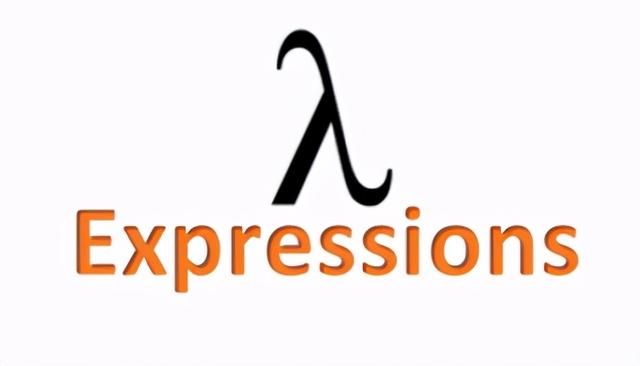1 什么是函数式编程
什么是“函数式编程”?顾名思义就是用函数来编程,那什么是函数呢?函数是一种特殊的方法,它声明了如何完成任务的定义,函数体内的不修改任何共享可变的数据,没有任何副作用。Java 8中的函数(方法)是“值”的一种新的形式,可以将方法作为参数进行传递。而主要作为参数进行传递的方法主要是“Lambda表达式”和“方法引用”。
2 Lambda表达式
Lambda表达式是一种匿名函数,在函数式编程里,它也可以作为参数进行传递。

2.1 了解Lambda表达式
我们来看一个简单的例子,先是用老式的匿名类定义,再使用等同的Lambda表达式。
- 匿名类:
Comparator byWeightComparator = new Comparator() { @Override public int compare(Person person1, Person person2) { return person1.getWeight().compareTo(person2.getWeight()); } };- Lambda表达式:
Comparator byWeightComparatorUsingLambda = (Person person1, Person person2) -> person1.getWeight().compareTo(person2.getWeight()); 从上面的例子我们可以看出Lambda表达式分为三个部分:
- 左侧:Lambda参数列表(Person person1, Person person2),等同于匿名类的compare方法的参数;
- 中间:箭头->,分开Lambda参数和Lambda体;
- 右侧:Lambda体,person1.getWeight().compareTo(person2.getWeight()),等同于匿名类的compare方法的返回值
Lambda表达式还有以下的规则:
- Lambda表达式可以有0到多个参数,如:
- () -> {}
- (Integer i) -> "wyf"
- (Integer i, Integer j) -> { return "wyf";}
- Java编译器有类型推断(Type inference)的能力,Lambda参数的类型可以省略,如:
(person1, person2) -> person1.getWeight().compareTo(person2.getWeight());- 若Lambda参数只有一个的话,可省略圆括号,如:a -> a+1。
- Lambda体需要用花括号围绕,如果体内只有一句表达式的话可省略。
- Lambda体中使用return的话,需要使用花括号,如:() -> { return "wyf";}。
2.2 Lambda表达式作为参数
Lambda表达式可以像参数一样传递给方法,看如下的示例:
List people = Arrays.asList(new Person("wyf", Gender.MALE, 100), new Person("www", Gender.FEMALE, 80), new Person("foo", Gender.FEMALE, 90));people.sort((p1, p2) -> p1.getWeight().compareTo(p2.getWeight())); //1people.forEach(person -> System.out.println(person.getName() + "的体重:" + person.getWeight())); //2- Lambada表达式作为sort方法的参数,是Comparator函数接口的实现。
- Lambada表达式作为forEach方法的参数,是Consumer函数接口的实现。
Person类的定义如下:
public class Person { private String name; //名字 private Gender gender; //性别 private Integer weight = 0; //体重 //无参构造 public Person() { super(); } //一个参数构造 public Person(String name) { this.name = name; } //两个参数构造 public Person(String name, Gender gender) { this.name = name; this.gender = gender; } //全参构造 public Person(String name, Gender gender, Integer weight) { this.name = name; this.gender = gender; this.weight = weight; }...省略getter、setter @Override public String toString() { return "名字是:" + name + "性别是:" + gender + "体重是:" + weight; }}Gender的定义如下:
public enum Gender { MALE, FEMALE}3 函数接口
上面的例子里面我们涉及到了很多函数接口,如:
- Function
- Consumer
- Comparator
它们都属于函数接口,都标记了@FunctionalInterface注解:如:
@FunctionalInterfacepublic interface Function...@FunctionalInterfacepublic interface Consumer ...@FunctionalInterfacepublic interface Comparator...任意只有一个抽象方法的接口都是函数接口(Functional Interface),这类接口的实现都可以使用Lambda表达式(或方法引用)。在定义中说到函数接口只有一个抽象方法,而函数接口里其实还有其它很多的方法,这些方法将被定义忽略,这些方法分别归类为:
- 静态方法:和接口有关的工具助手方法。使用static关键字,提供实现。
- 默认方法:添加新的功能方法到已有的接口,老的代码中使用了该接口其它方法的代码不会受到影响。使用default关键字,提供实现。
这也意味着从Java 8开始,接口内不仅仅只有抽象方法,还可以有静态方法和默认方法。只要符合定义即使没有标记@FunctionalInterface也是函数接口,当然如果不符合函数接口的定义即使标记了@FunctionalInterface,编译器就会报错,这就是@FunctionalInterface的作用。
函数接口主要在java.util.function包下,主要分成下面几类:
- Predicate:有输入,输出布尔值的函数;
- Function:有输入有输出的函数;
- Consumer:有输入无输出的函数;
- Supplier:无输入有输出的函数;
- Operator:输入输出为相同类型的函数;
3.1 Predicate-断言
Predicate的源码定义为:
@FunctionalInterfacepublic interface Predicate { boolean test(T t);}Lambda表达式即为test方法的实现,从test方法的定义我们可以看出,test方法接受任意类型的参数T,返回值boolean,我们可以用下面的表达式定义:
Predicate emptyPredicate = (String s) -> s.isEmpty()
根据类型推断可缩写为:Predicate emptyPredicate = s -> s.isEmpty()。
使用当前Predicate定义,可通过test方法执行:
Predicate emptyPredicate = s -> s.isEmpty();System.out.println(emptyPredicate.test("wyf"));输出的emptyPredicate.test("wyf")返回值为false。
3.1.1 组合Predicate
Predicate接口包含:negate、and、和or方法,可以重用已有的Predicate并组成复杂的Predicate。
- negate:已有Predicate的否定
Predicate nonEmptyPredicate = emptyPredicate.negate();- and:相当于逻辑运算的&&。
Predicate greaterThan0 = i -> i > 0;Predicate lessThan100 = i -> i < 100;Predicate between0And100 = greaterThan0.and(lessThan100);只有在i > 0且i < 100的情况下,test方法的返回值才为true。
- or:相当于逻辑运算的||。
Predicate greateThan0OrLessThan100 = greaterThan0.or(lessThan100);在i > 0 或i < 100时,test方法的返回值是true。
3.1.2 原始数据类型Predicate
Java会自动将包装类型拆包成原始数据类型,但这意味着性能的损失,所以当数据为原始数据类型时候,Java 8提供了一些特殊的Predicate。
- IntPredicate:当入参是int型时;
Predicate greaterThan0 = i -> i > 0;
可修改为:
IntPredicate intGreaterThan0 = i -> i > 0;
- DoublePredicate:当入参为double型时;
- LongPredicate:当入参为long型时;
3.1.3 两个参数的Predicate
Java还给我们提供了两个入参的Predicate叫做 - BiPredicate
@FunctionalInterfacepublic interface BiPredicate { boolean test(T t, U u);}Test方法接受两个入参,类型分别为T和U,我们可以定义为:
BiPredicate isLongThanGivenLength = (str, len) -> str.length() > len;第一个入参T为类型为String(str),第二个入参U类型为Integer(len)。
3.2 Function-函数
Function的源码定义为:
@FunctionalInterfacepublic interface Function { R apply(T t);}同样Lambda表达式是apply方法的实现,apply方法接受任意类型的参数T,返回值类型为R,我们可以用下面的表达式定义:
Function lengthFunction = str -> str.length();入参T类型为String(str),返回值R类型为Integer(str.length()),使用当前Function定义,可通过apply方法执行:
Function lengthFunction = str -> str.length();System.out.println(lengthFunction.apply("wyf"));输出的lengthFunction.apply("wyf")返回值为3。
3.2.1 组合Function
Function接口函数也为我们提供了andThen和compose方法组合已有的Function,组合的返回值仍为Function。先定义两个将被组合的Function:
Function plusFunction = x -> x + x ;Function multipleFunction = x -> x * x;- andThen:新的Function是组合第一个函数的返回值作为第二个函数的输入。
Function andThenFunction = plusFunction.andThen(multipleFunction);System.out.println(andThenFunction.apply(2));执行时,plusFunction先执行,返回值作为multipleFunction的入参再执行,结果为16。
- compose:新的Function是组合第二个函数的返回值作为第一个函数的输入。
Function composeFunction = plusFunction.compose(multipleFunction);System.out.println(composeFunction.apply(2));执行时,multipleFunction先执行,返回值作为plusFunction的入参再执行,结果为8。
3.2.2 原始数据类型Function
像Predicate一样,Function也有原始数据类型的Function,主要有三类:
第一类入参固化为函数接口,返回值类型R,仍需在范型中定义:
- IntFunction:入参为int。上面的plusFunction可修改为:
IntFunction intPlusFunction = x -> x + x ;- LongFunction:入参为long。
- DoubleFunction:入参为double。
第二类是返回值固化为函数接口,入参类型T仍需在范型中定义:
- ToIntFunction:返回值类型为int。
ToIntFunction toIntFunction = str -> str.length();System.out.println(toIntFunction.applyAsInt("www"));- ToLongFunction:返回值类型为long。
- ToDoubleFunction:返回值类型为double。
第三类是入参和返回值都固化为函数接口:
- IntToLongFunction:入参为int,返回值为long。
IntToLongFunction intToLongFunction = i -> i;System.out.println(intToLongFunction.applyAsLong(1));- IntToDoubleFunction:入参为int,返回值为double。
- LongToIntFunction:入参为long,返回值为int。
- LongToDoubleFunction:入参为long,返回值为double。
- DoubleToIntFunction:入参为double,返回值为int。
- DoubleToLongFunction:入参为double,返回值为long。
3.2.3 两个入参的Function
Function是一个入参T和一个返回值R,Java还提供了BiFunction,源码定义为:
@FunctionalInterfacepublic interface BiFunction { R apply(T t, U u);}Apply方法接受两个参数T和U,返回值为R,我们可以用下面的表达式定义:
BiFunction totalLengthBiFunction = (str1, str2) -> str1.length() + str2.length(); System.out.println(totalLengthBiFunction.apply("wyf","www"));apply方法的第一个入参T是String(str1),第二个入参U是String(str2),返回值是两个字符串长度之和,执行apply方法输出为6.
同样BiFunction也有很多的原始数据类型函数:
- ToIntBiFunction:返回值为int型。
- ToLongBiFunction:返回值为long型。
- ToDoubleBiFunction:返回值为double型。
3.3 Consumer-消费者
Consumer顾名思义消费而不生产,Consumer的源码定义如下:
@FunctionalInterfacepublic interface Consumer { void accept(T t);}从accept方法的定义中可以看出,accept方法接受一个参数T,没有返回值,我们可以用下面的表达式定义:
Consumer helloConsumer = str -> System.out.println("Hello " + str + "!");helloConsumer.accept("wyf");accept方法接受的参数T是String(str),没有返回值。
Consumer同样也有原始数据类型接口:
- IntConsumer:入参为int。
- LongConsumer:入参为long。
- DoubleConsumer:入参为double。
Consumer也有两个参数的BiConsumer接口,包含:
- ObjIntConsumer:第一个入参为任意类型T,第二个入参为int。
- ObjLongConsumer第一个入参为任意类型T,第二个入参为long。
- ObjDoubleConsumer:第一个入参为任意类型T,第二个入参为double。
3.4 Supplier-提供者
Supplier顾名思义是只生产不消费,Supplier的源码定义如下:
@FunctionalInterfacepublic interface Supplier { T get();}Get方法不接受参数,返回值为T,我们可以用下面的表达式定义:
Supplier systemTime = () -> System.currentTimeMillis();System.out.println(systemTime.get());get方法没有入参,返回值是Long型,输出当前系统事件。
Consumer同样也有原始数据类型接口:
- IntSupplier:返回值是int型。
- LongSupplier:返回值是long型。
- DoubleSupplier:返回值是double型。
- BooleanSupplier:返回值是boolean型。
3.5 Operator-操作者
Operator其实是一种特殊的Function,它的输入和返回值都是同一种类型。
3.5.1 UnaryOperator
UnaryOperator继承了Function接口,如定义:
@FunctionalInterfacepublic interface UnaryOperator extends FunctionUnaryOperator接受一个入参T,返回值也是类型T。
同样UnaryOperator也有原始数据类型的函数接口:
- IntUnaryOperator:入参返回值都为int型。
- LongUnaryOperator:入参返回值都为long型。
- DoubleUnaryOperator:入参返回值都为double型。
3.5.2 BinaryOperator
BinaryOperator继承了Function接口,如定义:
@FunctionalInterfacepublic interface BinaryOperator extends BiFunctionBinaryOperator接受的两个入参类型都为T,返回值类型也是T。
同样BinaryOperator也有原始数据类型的函数接口:
- IntBinaryOperator:两个入参和一个返回值都是int型。
- LongBinaryOperator:两个入参和一个返回值都是long型。
- DoubleBinaryOperator:两个入参和一个返回值都是double型。
3.6 Comparator
Comparator是我们经常用来比较排序所用的一个函数接口,它的定义:
@FunctionalInterfacepublic interface Comparator { int compare(T o1, T o2);}若o1小于o2,返回负数;若o1等于o2,返回0;若o1大于o2,返回正数。我们可以用Lambda表达式来定义:
Comparator byWeightComparatorUsingLambda = (person1, person2) -> person1.getWeight().compareTo(person2.getWeight());Comparator函数接口还为排序提供了comparing的静态方法,它接受一个Function来获取处理数据的排序key,上面的语句可以简写成:
Comparator byWeightComparatorUsingStatic =Comparator.comparing(Person::getWeight);3.7 自定义函数接口
函数接口的定义主要是看入参和返回值,前面我们有一个入参的Function,有两个入参的BiFunction,我们现在自定义一个有三个入参的TriFunction。
@FunctionalInterface //1public interface TriFunction { R apply(T t, U u, W w); //2}- @FunctionalInterface标记为函数接口
- Apply方法接受三个入参T(t)、U(u)和W(w),返回值为R。
我们可以通过如下Lambda表达式调用:
TriFunction lengthTriFuntion = (str1, str2, str3) -> str1.length() + str2.length() + str3.length();System.out.println(lengthTriFuntion.apply("wyf", "www", "foo"));第一个入参String(str1),第二个入参String(str2),第三个入参String(str3)以及返回值类型为Integer,计算输出三个字符串的长度之和,输出结果为9。




















 2325
2325

 被折叠的 条评论
为什么被折叠?
被折叠的 条评论
为什么被折叠?








